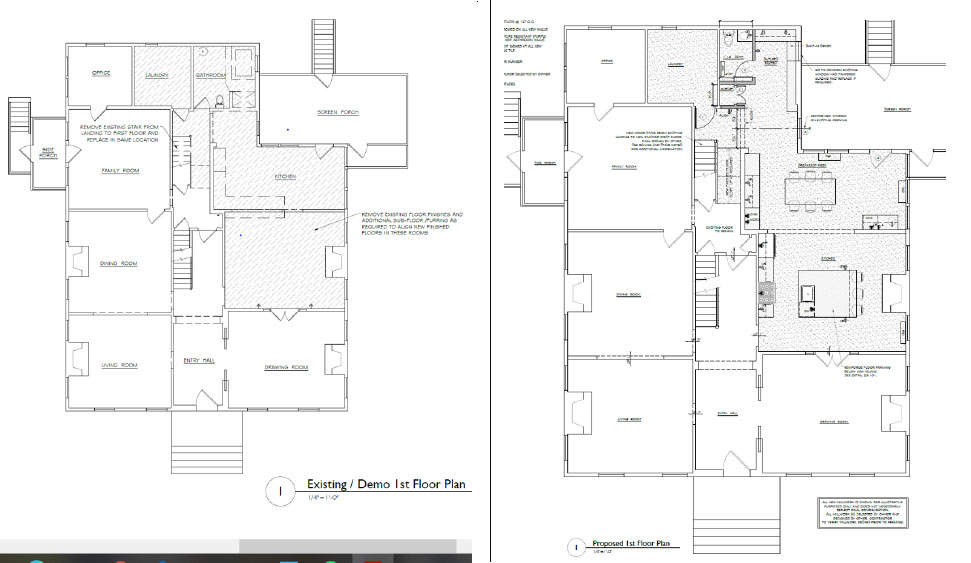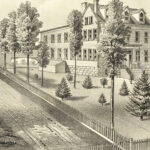Past Forward
Writer Meg Fox | Photographer Tom Grimes | Designer Deborah Leamann | Location Lawrenceville, NJA historic home honors its place in history and crafts a new narrative in classic form
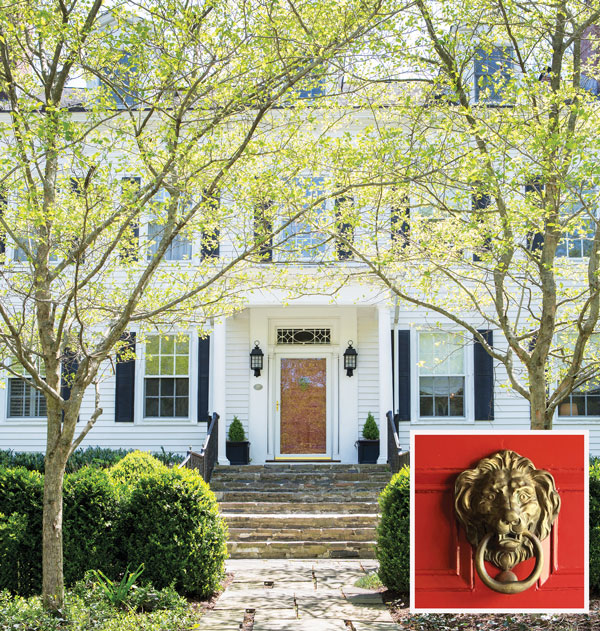
The classic Greek Revival-style home — built circa 1828 — is listed on the historic register.
Inset: If doorknockers could talk: This brass lion has seen guests coming and going for nearly two centuries.
When a professional couple and their two sons relocated to Lawrenceville, New Jersey, they welcomed the “almost no” commute to nearby jobs and schools, the walking distance into town and the accessible bike trails from their newly purchased property: a circa 1828 structure, known as the Davis House, that came with all its charms and quirks. For the record, three-time Pulitzer Prize winning author Thornton Wilder really did sleep there (see “Storied Past” below).
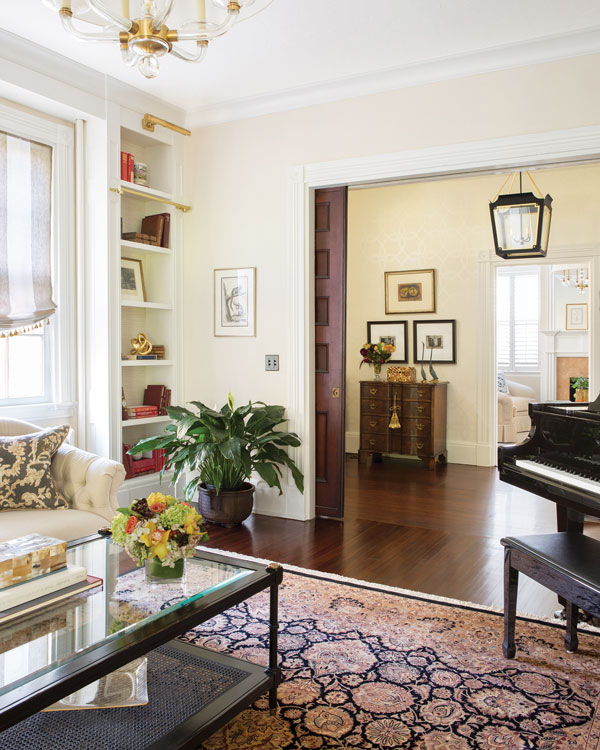
In the entrance hall (just beyond the doorway), a vintage English chest is juxtaposed with modern art, creating a tension between old and new. The lantern-style chandelier is a modern interpretation of a classic form, interior designer Deborah Leamann notes. Original walnut pocket doors lead to the drawing room in the foreground. Across the hall is the formal living room.
Though owning an old home was long on the homeowners’ wish list, this one came with some surprises — and nightmares: unlevel floors, lack of a cohesive floor plan, a variety of ill-conceived updates and, in some cases, no updates at all. Interior doors, with their mishmash of doorknobs, were also falling off their hinges, interior designer Deborah Leamann recalls.
The designer, well known for her love of older homes, came highly recommended to the couple, who sought to restore and revamp the interior for modern living. “I had just come off the renovation of an 1882 Victorian home, so I was in gear to grab the wheel and take charge,” says Leamann, principal of Pennington, New Jersey-based Deborah Leamann Interior Design.
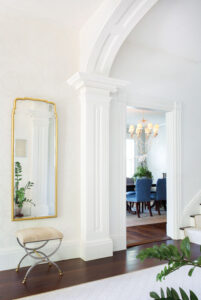
Plaster wall surfaces and authentic, character-rich details — archways, columns, fluted casings and pine floors — were preserved and carefully restored. The 1970s-era X bench in the entrance hall is reupholstered in a fun leopard print from Anna French. The full-length mirror is from the same period.
The groundwork was set to remove the bad and restore the good. “We knew we would keep and restore the steam radiators, pine floors, Ionic column-style fireplace mantels, rope-operated windows” and other features unique to the house, Leamann says. Leaded-glass transom windows and panel wall details “were a few of the details I wanted to celebrate and showcase,” she says. “Being authentic to the house was critical for me while at the same time releasing it into the 21st century.”
Leamann worked within the existing footprint with help from Gordon Mitchell of Mitchell’s Woodworking & Designs in Westhampton and general contractor Douglas Fesmire of Fesmire Bros. Builders in Titusville. She completely reimagined the house, reassigning rooms and drafting a plan to fulfill the owners’ request for a new kitchen, butler’s pantry and powder room. “Although these spaces didn’t exist, I took a huge [unneeded] bathroom with a Jacuzzi in it and created the butler’s pantry and powder room — both with classic forms,” Leamann says. Hallmark design elements such as fluted case openings with rosettes, raised panels, mosaic tiles and wainscoting honor the integrity of the house. “By offering classic design elements with modern functionality, I have allowed the Davis House to tell a new story.”
The largest challenge was the uneven floors, Leamann says. “I am not speaking of off level — more like 2-inch step-ups, 2-inch step-downs. It was such a trip hazard.” A back staircase was removed and rebuilt so the floors could be the same height.
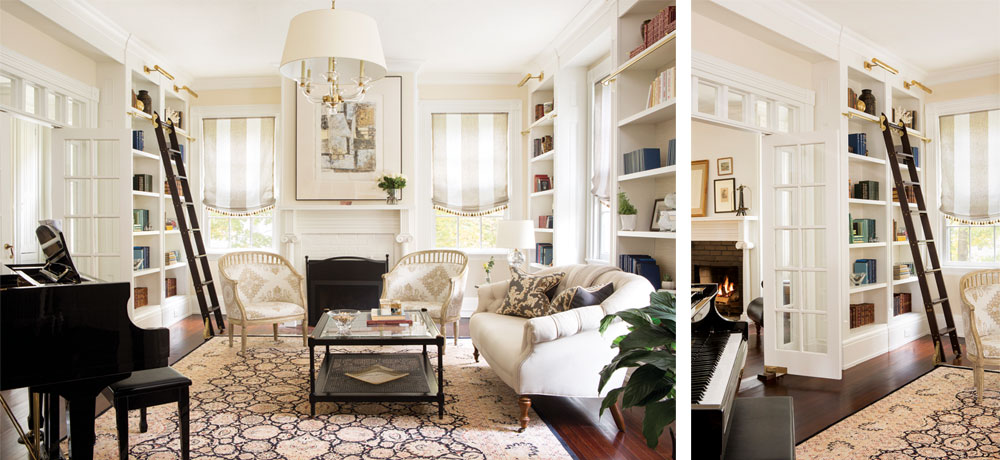
Antique books and other artifacts fill the newly installed custom bookcases around the perimeter of the drawing room — a multifunctional space used for reading, entertaining, piano playing and more. Ionic column-style fireplace mantels — here and elsewhere in the home — were restored to their former glory. Original French doors lead from the drawing room to the remodeled kitchen and adjoining breakfast area.
The kitchen? “It was a gut job [with] beyond-quirky cupboards” and other deficiencies, she says. An I-beam had to be installed between the kitchen and breakfast area, making venting the range tricky, she says. Fortunately, “I had a great team and expert problem solvers.”
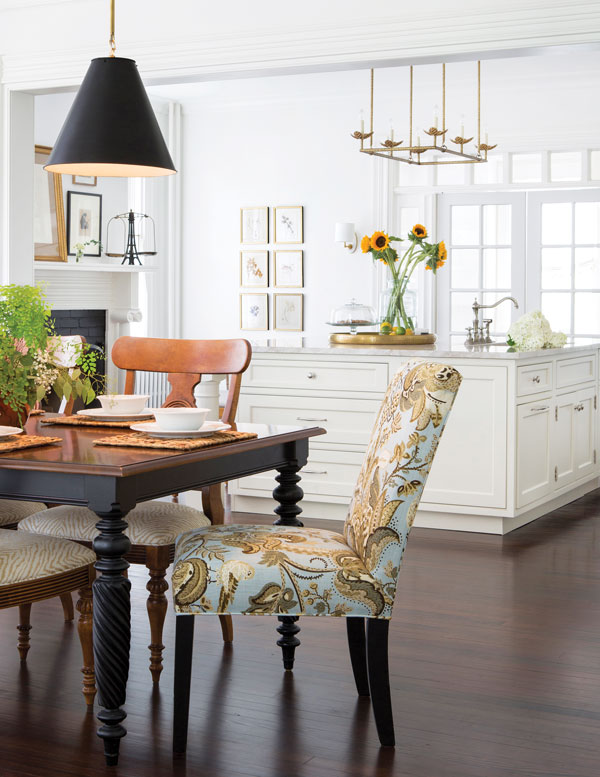
The renovated kitchen and breakfast area — crafted in familiar forms and harmonious proportions that respect the character of place — accommodates the needs of a modern family. The original fireplace remains intact. “Who wouldn’t love a fireplace in their kitchen?” Leamann asks. “It really is the focal point of the room.”

Custom cabinets are painted in Benjamin Moore’s “Cloud White.” The countertops are natural quartzite. Prefab wood flooring from a prior remodel was replaced with the same pine boards found elsewhere in the home. Existing track lighting also got the heave-ho in favor of classic fixtures — all on dimmers — to set the desired ambience. “We did not use any recessed lighting,” Leamann notes.

BEFORE PHOTOS: Quirky cabinets, bad track lighting and an inefficient floor plan plagued the existing kitchen and surrounding areas.
The new kitchen and breakfast area, fitted with off-white custom cabinetry and quartzite countertops, is clean, classic and highly functional. “Due to the unusual layout, I had to break the areas into zones, but I think that’s part of the charm,” Leamann says. Kitchen functions were extended into the breakfast area, which houses a wall oven, microwave and additional pantry storage; cabinetry on the opposite side of the room holds a coffee bar and wine cooler. Prefab wood floors were replaced with the same pine found elsewhere in the home, Leamann notes. A fireplace also remained intact. “Who wouldn’t love a fireplace in their kitchen?” she asks. Retaining the steam radiators and original windows was “icing on the cake.”
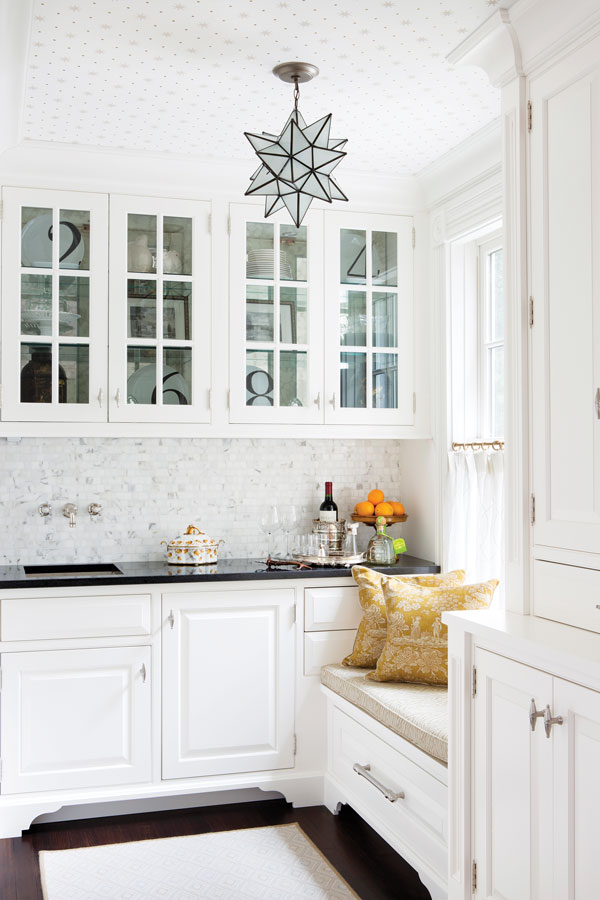
The butler’s pantry — along with an adjacent powder room and coat closet — was carved from an oversized and outdated full bathroom. A mosaic marble backsplash, black absolute granite countertop and finely crafted cabinetry and millwork harmonize with the rest of the home’s time-honored touches.
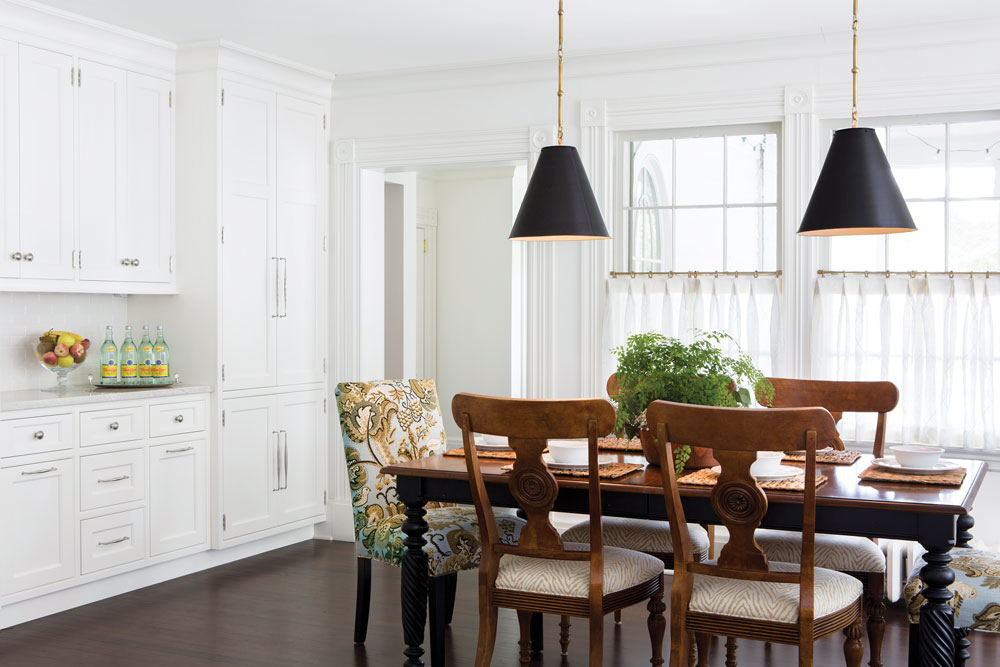
The breakfast area contains a wall oven, microwave (neither pictured) and additional pantry storage. A coffee bar on the opposite side of the room contains a wine cooler (not pictured).
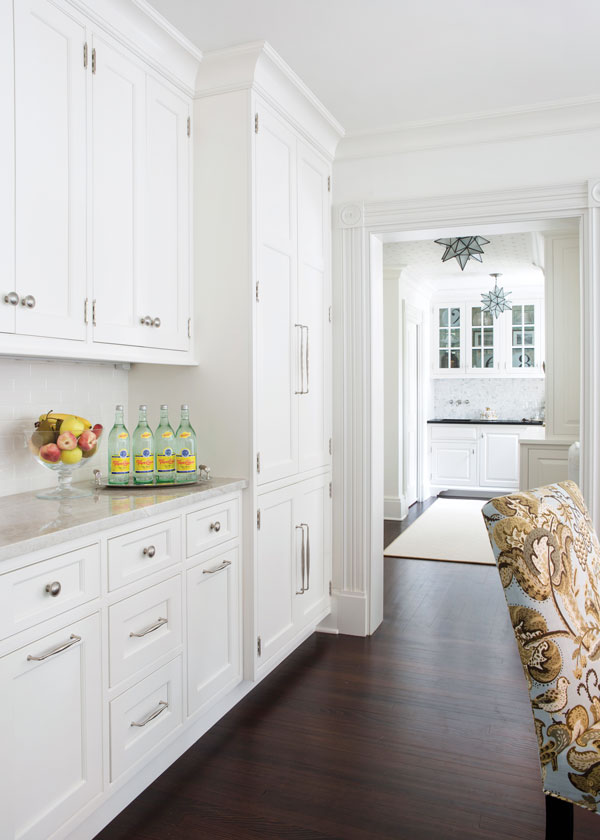
A wall was removed to create a visual flow to the new butler’s pantry and beyond. Details such as fluted cased openings with rosettes replicate the home’s unique architectural details.
During the renovation and restoration, “we took away the bad track lighting and DIY built-ins and kept the good,” Leamann says. “Lighting is paramount in creating a mood in a home.” She supplemented task lighting with stylish and classic chandeliers, sconces and pendants — all set on dimmers. Plastic toggle switches were swapped for reproduction push-button switches with mother-of-pearl inlay — “something you would expect to see in a house of this age,” she says. Other thoughtful improvements involved replacing any vinyl 1980s windows with proper divided lights. She also exchanged formerly mismatched doorknobs and hinges with carefully curated period hardware.
Walnut pocket doors, which were original to the home, lead to the drawing room just off the entrance hall. The drawing room is a multifunctional space that’s now used for reading, entertaining or practicing the piano. New custom bookcases with library lighting add character and function along with a variety of accessories and antique books from various estate sales or from the designer’s own collection. Like the walnut pocket doors, the Ionic column fireplace mantel — newly restored and freshly painted — maintains its place in history.
Leamann’s philosophy for designing a historic home? “Keep the foundation simple,” she says. “Light-colored paints with a tonal value keep the complexion of the home fresh while allowing the architectural elements to shine through.” Blending in antiques, she adds, “creates the authenticity and sensibility you would expect in a historic home.” Incorporating contemporary art and accessories keeps the interior fresh, “creating that transition from old to new.”

The new powder room blends traditional features with a playful tiger print wallpaper from Anna French.

BEFORE PHOTOS: Leamann carved out space for the new butler’s pantry and powder room from the existing oversized and unnecessary full bathroom with its space-eating Jacuzzi just off the kitchen.
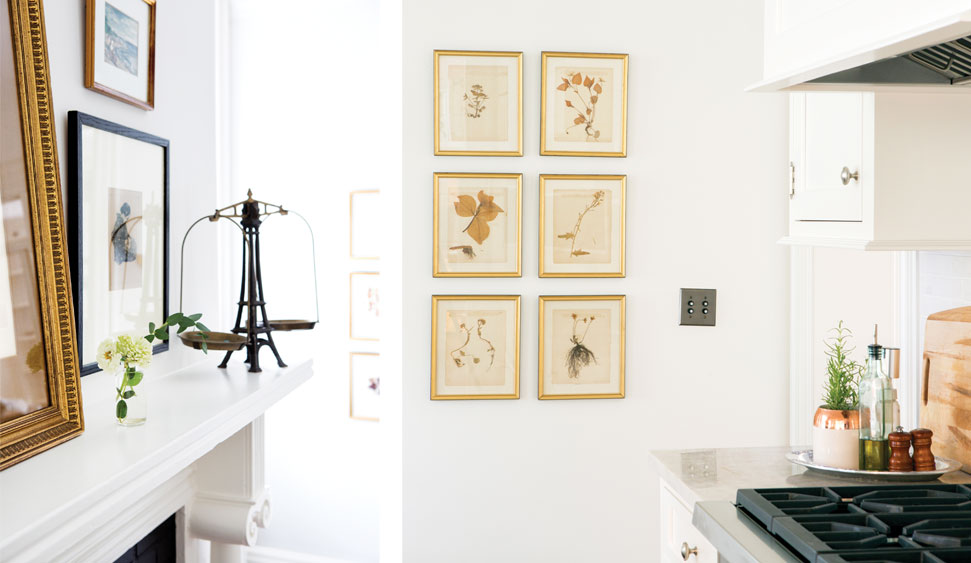
LEFT: Leamann found the antique Eiffel Tower scale from an antiques dealer in Kentucky. “I knew immediately that it would go on the mantel in the kitchen,” she says. | RIGHT: Framed pressed flowers from 1895 add a layer of antiquity to the new kitchen. Note the reproduction push-button switches with mother-of-pearl inlay. “They’re something you would expect to see in a house of this age,” Leamann says.
The Lawrenceville home, as seen in this 1830s rendering, operated for a time as a boarding house for female seminary students when Reverend R.H. Davis served as principal. It’s been known as the Davis House ever since. In the early 1900s, it housed male students from the Lawrenceville School before becoming a private residence around 1941.
When American playwright and novelist Thornton Wilder arrived at the Lawrenceville School in 1921 as a French instructor, he served as assistant housemaster at the Davis House for four years. During his Lawrenceville tenure, Wilder published The Trumpet Shall Sound, The Cabala and The Bridge of San Luis Rey, a Pulitzer Prize-winning novel, which he reportedly wrote while living in the home.

